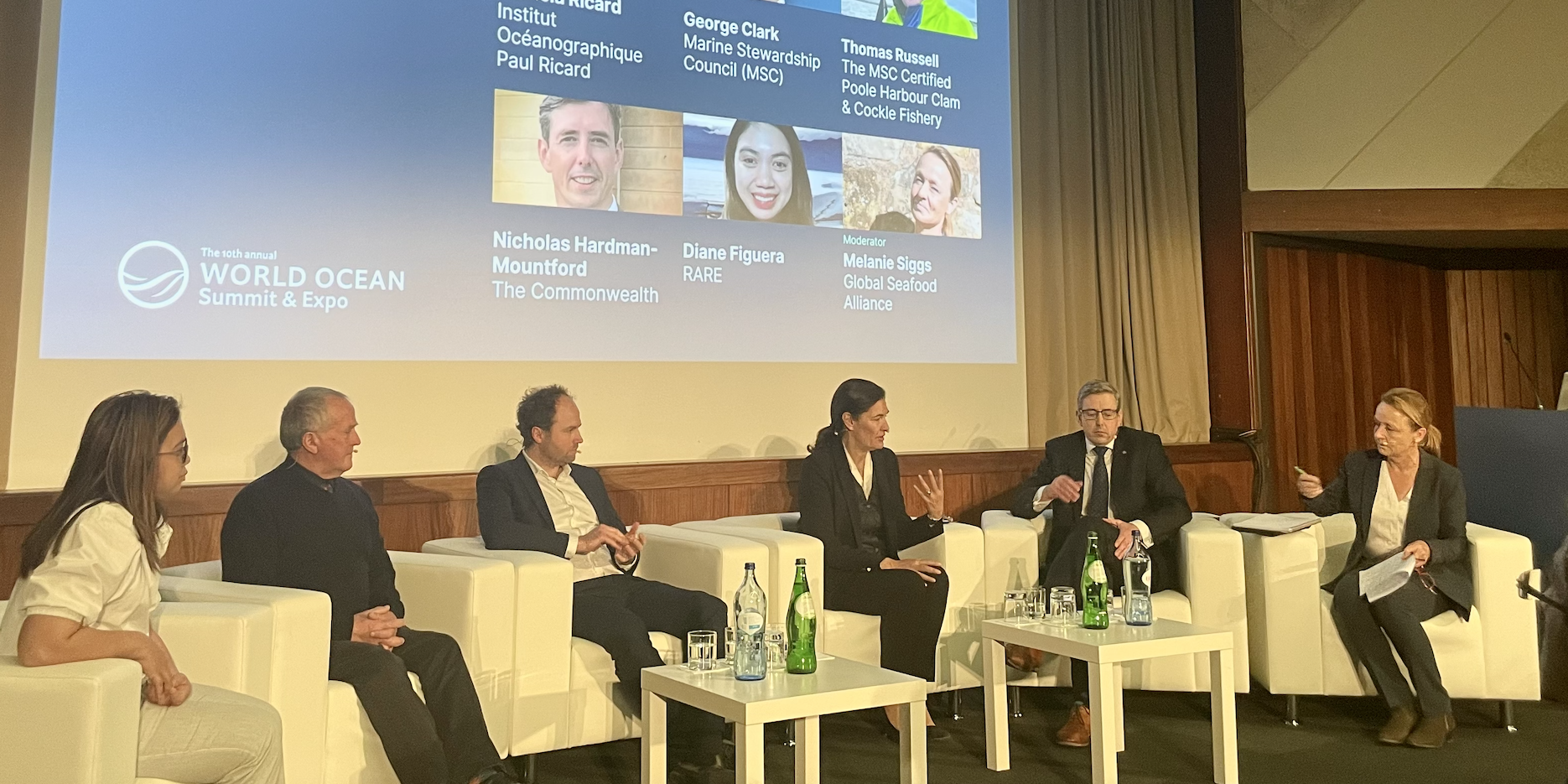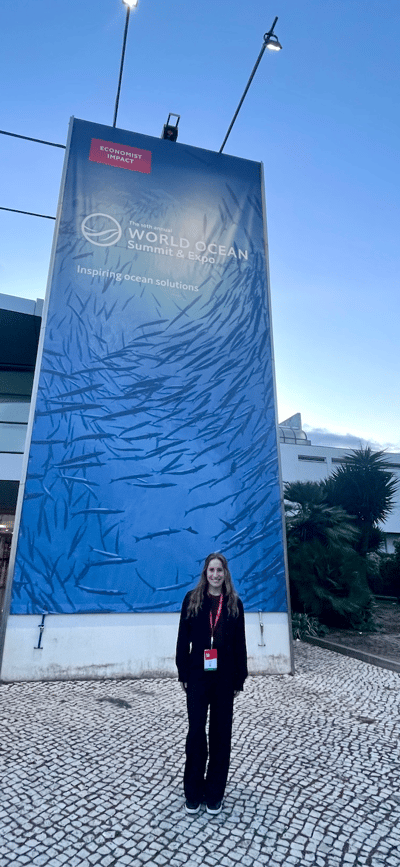Funding | Ocean | Propeller | Startups | Investing
The Economist World Ocean Summit From the Eyes of a (future) Investor

A few weeks ago, I had the opportunity to attend The World Ocean Summit hosted by Economist Impact as part of my ClimateCap Fellowship and on behalf of Propeller as their MBA Venture Capital intern. A few weeks later, I’ve now had time to reflect on my experience at the Ocean Summit, and look back on main takeaways from the keynote speeches, panel discussions, and meet and greet conversations. In doing so, I have pulled together the key themes I feel were central to the summit and are critical to achieving a sustainable blue economy.
 Key Theme #1: We can’t wait for a “perfect” system
Key Theme #1: We can’t wait for a “perfect” system
The ocean is the least funded UN Sustainable Development Goal, receiving only $10 billion from 2015-2019 compared to the $175 billion per year needed to achieve SDG 14 by 2030 (WEF). With this funding gap in mind, all panelists seemed to agree that we can’t afford to wait for a “perfect” system. During a panel on “Closing the Finance Gap”, Karen Sack, Executive Director of ORRAA, stated “We don’t need all the metrics. We have a clear path on what is necessary and we know what we need to do. We need to invest in action.”
Marisa Drew of Standard Chartered and Francisco Gomes of Ocean 14 Capital agreed, advocating for simultaneous work, and saying that we need to develop the metrics and reporting to prove positive impact, while also investing under the hypothesis that positive impact will result. It was clear from their discussion that a technical metrics approach and an intuitive approach can work hand in hand. But doing so will require us to learn from past mistakes and apply successful concepts from the terrestrial space to achieve the most efficient path forward.
Key Theme #2: We can’t work in Silos: Public Private partnership are critical
The ocean plays a critical role in the fight against the climate crisis, but ocean-based natural climate solutions receive less than 1% of climate finance. A common complaint from investors looking to finance marine nature based solutions (NBS) is a lack of “bankable projects” with an appropriate risk to return profile. At the Ocean Summit, panelists took this issue head on. Karen Sack, Executive Director at ORRAA, stated that we must redefine what it means to be a bankable project and that we must build in guarantees in order to engage the private sector and de-risk investment.
I firmly agree. The ocean is an incredibly unpredictable and harsh environment, but also incredibly resilient. We can’t force traditional risk-return concepts onto marine projects, but instead we need to create new ways of managing risk and consider co-benefits when analyzing the true value of investment.
This idea relies on the development of public-private partnerships to de-risk investment at the earliest stages of project development and support the ability to scale in later stages. During a panel on “Closing the Finance Gap to Meet SDG 14 Targets” Keith Lawrence of PEW Charitable Trust argued that partnerships can create the durable projects that are so needed by private investors. Lucy Holmes of WWF agreed, sharing that if investors are able to find ways to work together, then they can make real progress in funding the nature-based solutions needed in a truly sustainable ocean economy.
Key Theme #3: We need both speed and scale to develop a sustainable blue economy
After three days at the Ocean Summit, it was clear that exciting opportunities for investment exist across aquaculture, blue carbon, and biotechnology. But for investors, capitalizing on this innovation will require solutions to be developed at speed and at scale.
During the Aquaculture Investment panel, Francisco Gomes of Ocean 14 Capital shared his excitement for the sustainable fisheries sector, saying the aquaculture feed industry has the greatest alignment of economic and ecological incentives. The direct correlation between improving the health and function of marine ecosystems and greater aquaculture productivity results in investment opportunities with benefits across the triple bottom line.
When discussing the potential of blue carbon projects, Carlos Duarte, professor of marine science at King Abdullah University of Science and Technology (KAUST), argued that one third of needed carbon reduction can come from repairing nature. But in order to realize the greatest possible benefit of blue carbon ecosystems, we must think beyond mangroves, salt marshes, and seagrasses. Instead, every hectare of ocean has the potential to remove carbon and we must think holistically and creatively to maximize the carbon storing potential of the oceans.
Ana Brazão of the Oceano Azul Foundation emphasized the potential of blue biotechnology on a panel titled “Harnessing blue biotechnology to tackle the world’s economic challenges”. She argued that understanding the potential of blue biotechnology is key, as these solutions have major potential in achieving both decarbonization goals and increasing value chain resilience.
What this means for ocean investors
As ocean investors, we are well aware of the $2.5 trillion dollars the blue economy contributes annually to the global economy, and the ocean’s potential in addressing the climate crisis. However, as ocean investors, we also must be aware of the critical role we play in shaping the development of a sustainable and equitable blue economy.
If we are to realize the true value of oceans, our investment must be focused on maximizing positive impact, creating opportunities for collaborative partnerships, and enabling innovation at speed and at scale. This approach will look different across different ocean sectors. For blue carbon projects, supporting youth empowerment and community engagement is key to long-term success. For blue biotechnology, success requires thinking local and selecting the right species to work with existing ecosystems. For seaweed cultivation, facilitating female empowerment while also delivering on supply reliability and volume is critical.
As you can see, the path to success for each sector within the blue economy is as varied as the ocean itself. Therefore, we must think creatively and work collaboratively to find the right answer. A great example of successful collaboration took place just a few days after the conclusion of the summit when United Nations member countries passed a historic High Seas Treaty to protect biodiversity in the open ocean. Further proving that working together works.
Together we can push ocean innovation to solve the climate crisis.

.png)